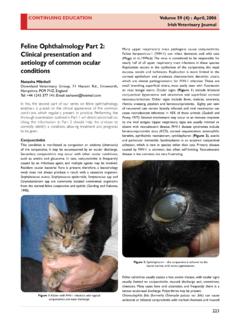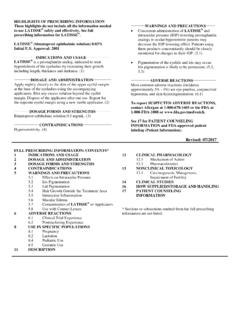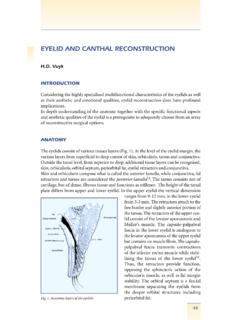Transcription of Enucleation in companion animals - Eye Vet
1 Irish Veterinary Journal Volume 61 Number 2108continuing educationEnucleation in companion animalsNatasha Mitchell MVB CertVOphthal MRCVS City Vet, 12 Lord Edward Street, Limerick, Ireland. Figure 1: A 10-year-old Bassett hound with acute ocular pain, episcleral congestion, corneal oedema, fixed pupil and lack of visual responses due to acute 2: A smooth, dark mass is occupying most of the anterior chamber in the eye of this 12-year-old domestic short-haired cat with an intraocular 3: A painful, non-visual eye in a one-year-old domestic short-haired cat with scleral rupture due to a gun shot, with the entry wound visible above the 4: A two-year-old Shih Tzu 20 minutes after traumatic proptosis of the left eye.
2 The dog was scruffed by another is the surgical removal of the globe. It is most often carried out in blind, painful eyes which are unresponsive to treatment. In appropriate cases, Enucleation offers a humane alternative to constant pain, the threat of neoplasia metastases, or euthanasia of an otherwise healthy animal . While it is a procedure which is well tolerated by pets, owners may find the issue very emotive and therefore have a resistance to the concept of Enucleation . However, if the eye is blind and painful, there is no doubt that the animal will be very much happier without it. Many owners wish they had taken the advice sooner when they see the result in the animal s overall comfort and improved demeanour after the for enucleationIndications for Enucleation include the following: Raised intraocular pressure resulting in glaucoma (a very painful and blinding condition) which is unresponsive to treatment (Figure 1); Intraocular neoplasia with the potential to cause severe intraocular pain or to metastasise, which is not amenable to alternative medical or surgical treatments (Figure 2).
3 Severe trauma resulting in a perforated eye or damage to the lens often a result of a cat scratch, a dog bite or a road traffic accident (Figure 3); Intraocular infection / endophthalmitis; Phthisis bulbi a small shrunken globe may cause no problems but if it is chronically inflamed or is causing secondary entropion, these globes should be removed; Proptosis where there is extensive severing of the extraocular muscles, significant damage to the globe itself or obvious avulsion of the optic nerve (Figure 4); and, Retrobulbar disease such as neoplasia, where the only access is through the for surgeryThere are a variety of Enucleation techniques.
4 The method chosen depends on specific factors relating to the eye, as well as the surgeon s preference and experience. The animal will need to be suitable for a general anaesthetic, although in an emergency situation, certain risks are acceptable. There are certain anaesthetic considerations to take into account. Monitoring of the anaesthetic will be made more difficult for the anaesthetist because the face will be covered during surgery by the drape. The anaesthetist will not be able to use the palpebral reflex, assessment of globe position or jaw tone to assess the depth of anaesthesia. Remote monitoring (Figure 5) may be facilitated by the placement of an oesophageal stethoscope, a pulse oximeter (with the probe attached to the prepuce or vulva for easy 109continuing educationIrish Veterinary Journal Volume 61 Number 2replacement), a capnograph, a rectal thermometer and a blood pressure monitor alongside palpation of the femoral pulse.
5 In preparing for surgery there are several important points to remember: It is recommended to mark the eye to be removed in front of the owner with Tippex (Figure 6) or a marker. This should help prevent a serious mistake. Essential equipment should be assembled (Table 1). The endotracheal tube tie should be secured around the lower jaw rather than around the head, in order that it stays as far away from the surgical site as possible (Figure 7). Eye ointment or gel should be placed on the corneal surface to minimise hair clippings entering the periorbital area, as these short hairs are difficult to remove afterwards (Figure 7).
6 The area approximately 3cm around the eye is clipped, taking care not to traumatise the thin eyelid skin. The conjunctival sac, the globe and the periocular area should be prepared for aseptic surgery using dilute povidone iodine solution at a concentration of 1:50. While in this case the eye will be enucleated, it is best practice to use non-detergent based iodine around the eye as the detergent can cause severe damage to the eye. The head is positioned optimally and this is facilitated by the use of a buster cushion (Figure 8). The surgeon may stand or be seated, depending on which position they find the most comfortable.
7 Veterinary ophthalmologists tend to remain techniquesChoosing a technique for Enucleation depends on the objectives to be achieved. Factors to take into account include the reason for Enucleation and the cosmetic outcome desired. Owners may wish to discuss the benefits and disadvantages of various techniques before the operation, as discovering that an alternate technique could have been performed could lead to feelings of disappointment 5: Remote monitoring of the patient is important as access to the head area will not be possible under 6: The left glaucomatous eye has been marked with Tippex pre-operatively to avoid any possible 7: The endotracheal tube is secured around the lower jaw to keep it out of the way of surgery.
8 Gel tears are placed on the eye before clipping to reduce the number of hairs that can fall into the Table 1: Equipment needed for Enucleation in companion animals * Sterile drapes* Scissors: Steven s tenotomy scissors, curved Metzenbaum scissors or Mayo scissors* Toothed forceps for grasping the conjunctiva* Curved haemostats* Needle holders with small tip for grasping finer needles* Swabs* Pot of formalinIn addition, the trans-palpebral / exenteration techniques require:* Allis tissue forceps * Scalpel handle* Scalpel blade* Implants:Silicone prostheses, available in a variety of sizes 14-22mm for small animals * Carter sphere introducer* Spay hook, two artery forceps or evisceration scoop* Suture material: Fine absorbable suture material with swaged-on needles contribute to a more atraumatic repair with good apposition and optimal size of suture material used depends on the surgeon s preference, but it is usual to use 3/0 to 6/0 non-absorbable monofilament materialIrish Veterinary Journal Volume 61 Number 2110continuing education1.
9 Trans-conjunctival enucleationThe advantages of this technique are that the periorbital fat and extraocular muscles are retained, which improves the cosmetic result. It is also less traumatic, there is less haemorrhage and better exposure of the optic nerve and orbital vessels can be achieved. A disadvantage is that any infectious organisms in the conjunctival sac will be introduced into the orbit once the conjunctival space is breached. Another disadvantage is that more tissue will be left behind, which is clearly not desirable where there is extension of tumours lateral canthotomy is performed to increase surgical exposure.
10 An eyelid retractor may be used when this is preferred by the surgeon, although this is not essential. The third eyelid is grasped and removed, along with the gland of the third eyelid, using tenotomy scissors. A 360 conjunctival incision is made 2-3 mm posterior to the limbus and extended posteriorly, bluntly dissecting the conjunctiva and Tenon s capsule from the globe. Just enough conjunctiva should be left attached posterior to the limbus for grasping with a forceps, to facilitate manipulation of the globe. The extraocular muscles are transacted close to their insertion on the globe. The optic nerve and associated blood vessels are clamped with a curved artery forceps.










